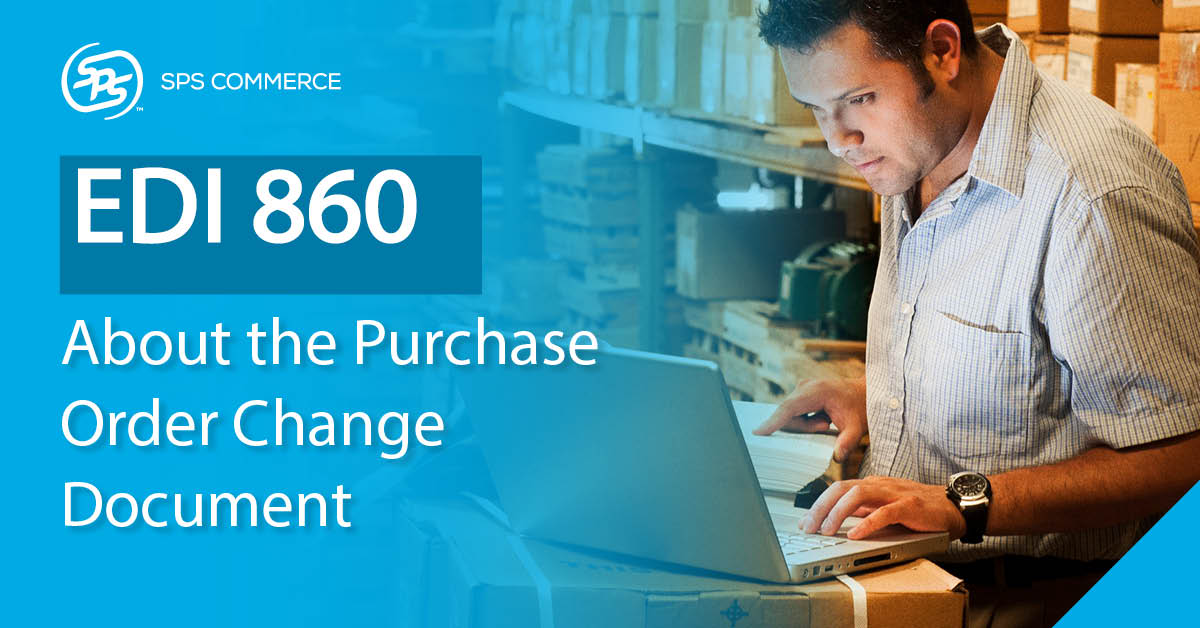Purchase Order Changes (EDI 860): What are the Benefits for Buyers and Sellers?
The Purchase Order Change is a fundamental EDI document for improving inventory management, supply chain efficiency and financial accuracy.
The Purchase Order Change is commonly known as the EDI 860. This document ensures that a final order is correct. It also helps with invoice reconciliation and proper, accurate payment.
What is an EDI 860 (purchase order change request)?
The purchase order change request is typically sent from a buyer (retailer or distributor) to a seller (vendor or supplier) when a revision to a previously submitted purchase order is required. This document provides information describing the original purchase order, as well as the changes needed.
Purchase order changes can occur at different times within the order cycle. For example, a buyer could send the EDI 860 to correct pricing. Or a buyer might send this document if the balance of the order needs a quantity adjustment or a new ship date. Buyers also use the EDI 860 to cancel an order.
It’s also important to note that some businesses don’t use this document at all. Instead, buyers provide an updated 850 EDI purchase order.
Looking for detailed specifications of the EDI 860? Get more information in our EDI guide.
Why should buyers care about EDI 860 compliance?
Providing a consistent way to communicate order changes as well as having an audit trail is becoming more important for all trading partners.
Here are some key benefits of the EDI 860 for buyers:
- More accurate and faster order fulfillment
Automation of purchase order changes allows faster order fulfillment with fewer errors. Typically, buyers can reduce lead time by two to three days with electronic versus faxed or emailed orders.
- Reduce in-store and warehouse safety stock and inventory
When used in conjunction with other automated EDI documents, the EDI 860 allows buying organizations to reduce inventory by up to 5 percent. Retailers that practice just-in-time inventory should consider enabling and integrating EDI 860. It helps buyers order only as many products as needed, exactly when they are needed. - Improve invoice reconciliation
Without automation, approximately 30 percent of invoices will have issues related to payment terms, quantity or pricing. Automating the order cycle eliminates the need for human intervention along with time-consuming and costly errors. Electronic purchase order changes also ensure that the retailer doesn’t overpay for items that weren’t delivered.
How do suppliers benefit from the EDI 860?
If your retail customer has asked you to use the EDI 860, here are some potential benefits for your organization:
- Focus on more value-added work
By automating the receipt of order changes, you can avoid time-consuming paperwork and emails. This allows your team to focus on more value-added tasks.
- Process orders more efficiently
The EDI 860 reduces the time spent processing orders along with data entry errors. By automating the order process, you can reduce staffing costs and spend less time fulfilling orders. - More accurate invoicing
Electronic purchase order changes ensure that you invoice the retailer for the correct amount. This allows you to avoid overcharging or undercharging your customer, and having to fix invoicing errors down the road. - Sellers can also request PO changes
Sellers can send purchase order change requests to buyers, too. Depending on what the retailer or distributor supports, sellers might use the EDI 855 or EDI 865. This allows the buyer to choose to update or cancel the purchase order, and ultimately simplifies your order fulfillment within your warehouse.
How can you avoid common EDI 860 issues?
The most common issue with the EDI 860 is EDI mapping. EDI maps provide the detailed EDI specifications required by a specific trading partner. You will need a unique EDI map to connect your business with each of your trading partners.
When a trading partner requirement changes, your team will need to update the EDI maps. Mapping problems with the EDI 860 can cause an EDI transaction to fail.
The best way to eliminate the worry of EDI 860 issues is to rely on a full-service EDI provider like SPS Commerce. Full-service providers take ownership of understanding your trading partner requirements and making map changes. For example, the SPS team actively manages 9,000 map changes each year.
Want to learn more about the EDI 860?
EDI is fundamental for competing in the modern retail landscape. If you would like more details about the 860 Purchase Order Change Request, contact an EDI expert at SPS Commerce today.
For more insight into common EDI documents and transactions, check out our posts about EDI 850 purchase orders and EDI 856 advance shipping notices.
- Save big money with order automation - January 17, 2025
- A collaborative approach to supplier performance management - November 7, 2024
- How to nail your next buyer meeting: A supplier’s guide - August 29, 2024

RELATED POSTS
A Simple Guide to Understanding the G...
How to Choose an EDI Provider
EDI 852: Important Fundamentals of th...